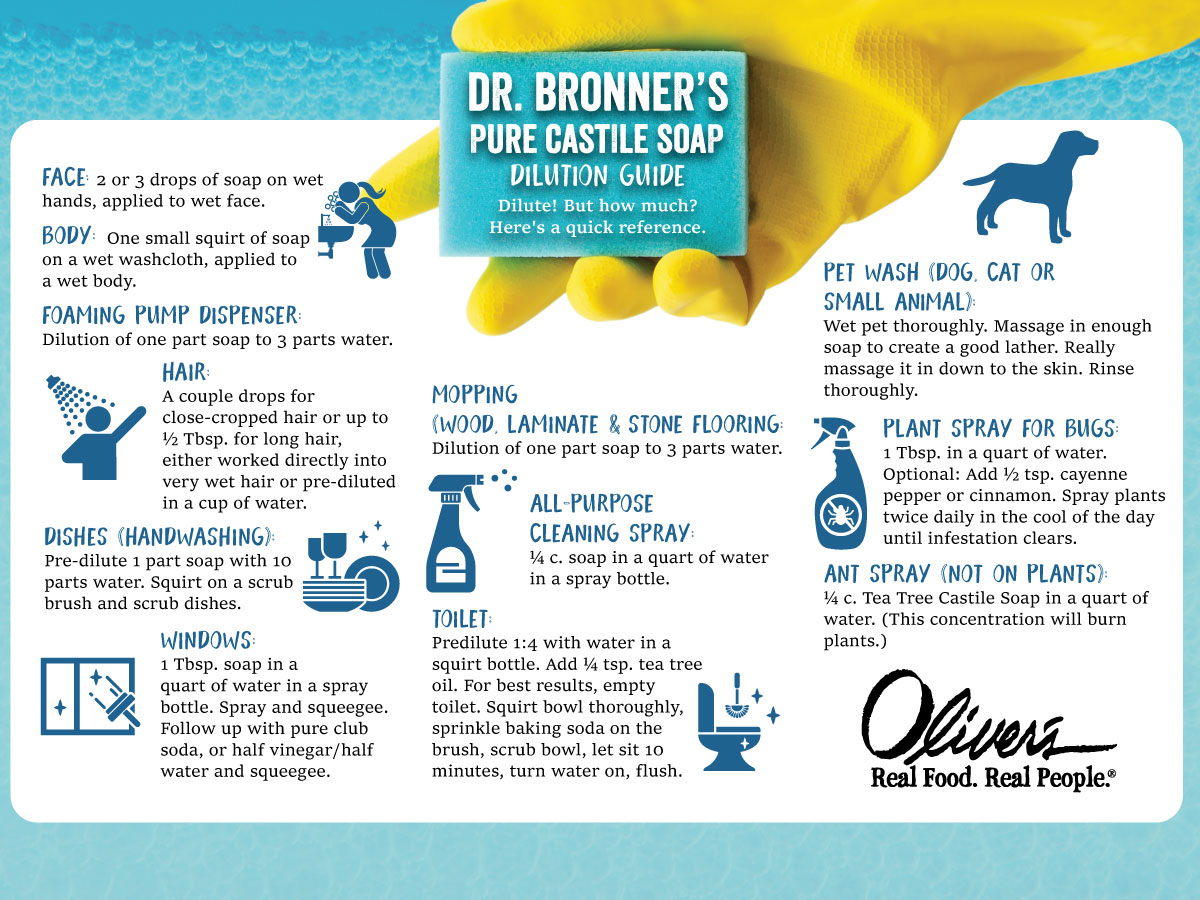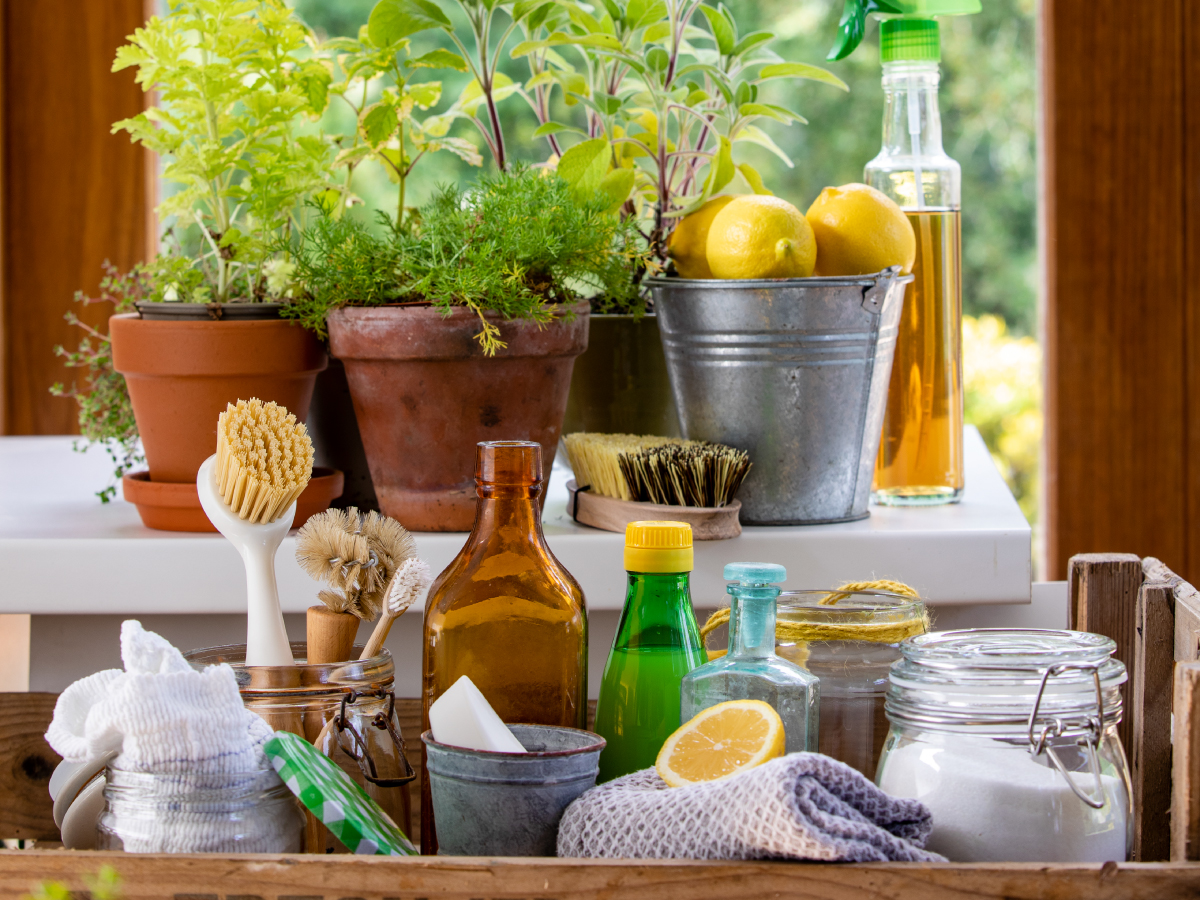Since the first Earth Day took place in 1970, annual Earth Day celebrations have done a great deal to bring our country’s pollution, climate, and waste problems into focus and in recent years locally, awareness and understanding of the amount of food waste we create has come to the fore. But though there is still much to do, there are many areas of pollution and waste that have actually improved as we have all moved toward embracing sustainability in our homes and communities. Small choices do matter.
Every year at Oliver’s, we like to address different parts of the sustainability equation with our customers. This year, we are highlighting eco conscious businesses (link to blog) AND how to take Spring Cleaning and sustainable living to a new level by reducing chemical use or adopting a new habit at home.
“Green Your Clean”
Did you know that many of the chemicals and products we buy in plastic containers for cleaning our home can be easily replaced with non-chemical recipes that you make yourself? With re-usable bottles and simple ingredients, think of the time, money, and earth friendly benefits you can achieve and give one or more of these a try!
Just for you, we have easy recipes for
- All Purpose Cleaner-2 ways
- Citrus Scouring Powder
- Dusting and Wood Cleaner
- Glass Cleaner; and
- Reusable Fabric Softener Dryer Sheets
We hope you will give one or more of them a try and see if you become a convert!
Dr. Bronner’s Soap Refills
In this week’s Ad, you will also see that we are featuring Dr. Bronner’s Pure-Castile Liquid Soap Refills, Selected Varieties. 32 oz. Carton $13.99. This is the OG natural soap with literally hundreds of uses. Dr. Bronner’s Soap Refill Carton is the same, great Magic Soap in a new recyclable container. The Soap Refill Carton is an FSC-certified paper carton with minimal plastic & aluminum lining for shelf stability—packaging chosen for its lower environmental impact! They are also a Certified B Corp and use 100% Post-Consumer-Recycled Packaging. Check out the great selection of scents and check out our handy chart of uses for Dr. Bronner’s below.

Everyday Green Living Tips
Have you ever noticed that you can read or hear something several times and then all of a sudden, it clicks for you? Well, that is our thought about some of these tips below. They are probably not new to you, but maybe given your Earth Day inspiration, one (or more) of them will resonate and you will be ready to give them a try. Here we go!
1. Replace traditional water fixtures with low-flow ones.
Save water (and money) by swapping old, inefficient water fixtures with environmentally friendly options! The vast amount of water Americans waste daily can be put down to activities most of us take for granted, like flushing the toilet or washing your hands. By using low-flow fixtures, the average household can save up to 13,000 gallons of water annually, all with minimal conscious effort. You’ll be doing the same activities as before and saving water at the same time; check out resources available through the City of Santa Rosa here, or contact your local agency to get started!
2. Divert or avoid food and garden waste.
The best way to avoid waste is to not create it the first place, and the kitchen is great place to put that idea into action. Make a list when you go shopping to avoid buying more than what you need; when you get home, use the “First In, First Out” (FIFO) method, arranging older food at the front of the fridge and placing newer items towards the back. This will help you to finish what you already had before getting started on the new stuff! When you’re cooking, save edible stems, peels, etc. for use in zero-waste recipes like this Ultra-Green Soup or an easy Parmesan Broth, or whip up a batch of DIY Citrus Cleaning Solution with homemade Apple Scrap Vinegar. And if you really can’t eat it, add it to your personal compost pile or place it in your Compost Bin for pick-up!
3. Choose plastic-free options wherever possible.
In a similar vein, opting for limited or sustainable packaging when shopping and paring down plastic use reduces waste by simply not creating it. If you can, buy in bulk using reusable bags, jars, and containers so you can buy exactly as much or as little as you need, no landfill required. If bulk options aren’t available, select items packaged sustainably; for example, instead of buying chicken packaged in plastic, why not grab it wrapped in paper from our Meat Counter? Or instead of buying bottles of your favorite beer, try it in cans – they’re easy to recycle, and take a lot less energy to produce. Even takeout can get the sustainable treatment! Support restaurants using Earth-friendly takeout packaging materials like paper or bio-plastics, or skip the packaging entirely by bringing your own, reusable packages.
Of course, while finding items with sustainable packaging is important, the content of the product inside the packaging shouldn’t be ignored! The average American wastes around 180 pounds of plastic each year, over half of in the form of single-use plastic items. Add it all up, and plastic waste ends up accounting for another 10% of the global waste produced every year, while plastic production uses at least 8% of the oil produced annually. Help curb waste and the production of greenhouse gasses by choosing reusable options for typically single-use items; we’ll talk a lot about bag in a minute, but there are also water bottles, utensils, straws, takeout containers, to-go coffee cups, and even resealable bags, to name a few. You can also swap typical, household items for versions made from sustainable materials. Try a bamboo toothbrush and natural floss for a green morning routine, or bring the eco-friendliness into the shower with shampoo and conditioner bars that don’t need plastic bottles. Also, keep your plastic Tupperware if you have it, but when it’s time to retire them, go for metal or glass options instead! And of course, always choose fabrics made from natural materials like hemp or cotton or recycled materials – the fire marshal will thank you, and the planet will too!
4. Shop in-store, and bring your own bags.
While the ability to shop online has certainly been a boon to many of us over the past year, it also has some real environmental drawbacks. First to consider is the extra packaging – usually for a single product – both when the product is initially shipped and in case it has to be returned. Then there’s the greenhouse gasses created in transport, about 24-times the amount generated in a solo run to the store. And the faster you want your items, the deeper the carbon footprint you leave – around three-times as deep. By simply buying several items in one physical trip to the store, you can start helping the environment and stop paying for shipping; it’s a sustainability twofer! While shopping in-store, avoid paper and plastic and instead choose to use reusable bags made from recycled materials. Unlike traditional, single-use bags, reusable bags can be kept in use for years, making for a lot less waste in landfills. Unfortunately, bags made from virgin cotton actually carry a greater environmental impact than their plastic cousins (thanks, manufacturing process…), so always opt for reusable bags made from recycled plastics or other recycled materials, and avoid buying new bags as much as possible.
5. Recycle old clothes, and shop at thrift stores.
Whether your clothes are like-new or nearly destroyed, there are tons of options for recycling clothes, and each one helps to cut down on the approximately 13 million tons of textile waste produced globally each year. Donate clothes that are still in good condition to thrift stores to be resold to someone new; if your clothes are truly fully worn out, look for local programs that accept and recycle rags. Most ask you to find their nearest donation bin or center, then you simply drop off your rags for recycling, and away they go! Also, give fast fashion (an industry which produces 10% of the world’s greenhouse gas emissions and uses about 25 trillion gallons of water annually) the haymaker with thrifted clothes! Thrifting prevents wearable clothes from ending up in landfills, all while avoiding the waste and pollution that goes into the production of new garments.
6. Reduce energy use and opt for renewable power sources, when available.
Going clean with your energy is one of the biggest ways to make a difference, whether it’s at home or in the community. According to federal data, the US wastes on average around 2/3’s of the energy we generate. You can address this on a small scale by reducing your energy use at home (particularly during peak hours, when energy use is highest), but also by urging local businesses and community organizations to make energy efficient changes wherever possible. This could be as simple as instituting a “lights off, plugs out” policy when rooms are unoccupied or as complex as installing a full solar array to generate your own energy. If you own a small business, check out some of the many sustainability programs currently in place at Oliver’s to start getting inspired!
Additionally, we’re always aware of the reasons we’re lucky to live in Sonoma County, but one major reason you might not be aware of is the availability of locally generated clean energy. As one of Sonoma Clean Power’s first customers, we’re proud to support their work to bring clean, sustainable energy to Sonoma County’s many businesses and private residents. They utilize a variety of clean energy sources in their efforts to provide a local PG&E alternative, including solar, wind, geothermal, hydroelectric, and biomass. Click here to learn more about Sonoma Clean Power and their efforts!
7. Talk to others about environmental responsibility.
Okay, we’re not going to lie – this one is both the easiest and the hardest. That being said, we feel it’s still the most important, as it is only through an open and honest discussion of climate change that we have begun seeing significant action taken to combat it. Though 7 out 10 Americans believe climate change is real and a threat, you’d be hard pressed to hear it mentioned in day-to-day conversation. By opening a dialogue on the environment and sustainability with those around you, you are helping to spread awareness and address the issues facing the planet in real-time. Your friends and family are more likely to listen to you than they are someone they don’t know, even if the person is an expert in the field, and this has been proven time and time again. Be a responsible climate activist and educate yourself first with resources from government agencies like NASA, NOAA, and the EPA, then take that information out into the world! “The easiest way to eat an elephant is one bite at a time” – the more people there are aware of climate change and how to stop it, the easier it will be! Click here to see the Nature Conservancy’s guide on how to get the ball rolling!
This week, celebrate Earth Day and help think about one or two small moves you can make to lighten your carbon footprint. Whether you try a new natural cleaner recipe or just start bringing your own bags when you shop, or get more serious about reducing your use of plastic, any small changes add up and make a difference for our dear Mother Earth.


No comments yet. Add the first comment